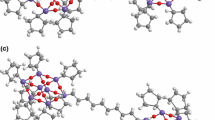Nucleophilic substitution reactions involving organomagnesium (Grignard) [1] and organolithium reagents have been used extensively for many years to form Si—C bonds (see Reaction Scheme 12.1). However, their use for the construction of hyperbranched polymers whose backbone contains, as a major structural component, silicon—carbon bonds, i.e., polycarbosilanes [2] is relatively more recent.
This chapter focuses on the application of such nucleophilic substitution reactions toward the synthesis of hyperbranched polycarbosilanes, with particular emphasis on those preparations that have resulted in relatively well characterized products. These syntheses are organized by the type of ABn monomer unit used (see Section 1.2), where A and B refer to the (C)X and (Si)Xn, respectively, functional ends of the monomer unit and where the nature of the coupling reaction leads to entirely or primarily Si—C bond formation. In most cases, these are “one-pot” reactions that employ monomers that bear halogen or alkoxy groups on the C and Si ends of the unit. Indeed, hyperbranched polycarbosilanes have been described, in general, as “obtained in one synthetic step via a random, one-pot polymerization of multifunctional monomers of AB n type” [2]. Treatment of the ABn monomer with either elemental Mg or an organolithium reagent, ideally (but not always) forms a complexed carbanion (the nucleophile) by reaction with the C–X end of the monomer unit, resulting in an intermediate of the type, (XxM)CSiXn, where M = Mg or Li, X = halogen or alkoxy, and x = 1 (Mg) or 0 (Li). Self-coupling of this reagent via reactions of the type shown in Reaction Scheme 12.1 leads to oligomeric and polymeric products that are connected primarily through Si—C bonds and yield an inorganic MXx by-product.
Access this chapter
Tax calculation will be finalised at checkout
Purchases are for personal use only
Preview
Unable to display preview. Download preview PDF.
Similar content being viewed by others
References
Kipping F S (1904) Proc Chem Soc 20:15
Interrante L V, Shen Q (2000) Polycarbosilanes. In: Jones R et al. (eds) Silicon-Containing Polymers, Kluwer, Dordrecht/Boston/London, p. 312
(a) Yajima S et al. (1976) Nature 260:683 (b) Yajima S et al. (1978) J Mater Sci 13:2569
Jones R H et al. (2002) J Nucl Mater Part 2 307–311:10157
Whitmarsh C K, Interrante L V (1991) Organometallics 10:1336
Starfire Systems, Inc. 10 Hermes Rd, Suite 100 Malta, NY12020
Zheng Chang-Feng (2006) Synthesis and characterization of polycarbosilane with grafted polyethylene oxide as polymer electrolytes, Ph.D. dissertation, Rensselaer Polytechnic Institute, Troy, NY
Rushkin I L et al. (1997) Macromolecules 30:3141
Interrante L V, Lu N (2004) US Patent 6,809,041, 1 Jan 2004; Rathore JS, Interrante LV, Dabois G, (2008) Adv. Funct. Mater., 18:1
Apen P, Wu H-J (2005) US Patent 6,841,256, 11 Jan 2005
Babich K et al. (2007) US Patent 7,172,849, 6 Feb 2007
Nakagawa H et al. (2006) US Patent 20,060,134,336, 22 June 2006
Houser E J, McGill R A (2006) US Patent 7,078,548, 18 July 2006
Lu Ning (2004) Hyperbranched polycarbosilanes: Synthesis, characterization and application, Ph.D. dissertation, Rensselaer Polytechnic Institute, Troy, NY
(a) Shen Q, Interrante L V (1997) J Polym Sci Part A Polym Chem 35:3193 (b) Shen Q, Interrante L V (1996) Macromolecules 29:5788
Shen Qionghua (1995) Preparation and characterization of new polycarbosilanes: Part 1, synthesis, characterization and thermal properties of substituted poly(silylenemethylenes); part 2, stoichiometric polycarbosilane precursors to SiC, Ph.D. dissertation, Rensselaer Polytechnic Institute, Troy, NY
Liu Q et al. (1999) Chem Mater 11:2038
Whitmarsh C K, Interrante L V (1992) US Patent 5,153,295, 6 Oct 1992
(a) Interrante L V et al. (1998) Low cost, near net shape ceramic composites by polymer infiltration and pyrolysis. In: Newaz G M, Gibson R F (eds) Proceedings of the 8th Japan—US Conference on Composite Materials, Technomic, Lancaster, PA, pp. 506–515 (b) Interrante L V et al. (1997) Fabrication and properties of fiber- and particulate-reinforced SiC matrix composites obtained with (A)HPCS as the matrix source. In: Key Engineering Materials, Transtec, Switzerland, Vols. 127–131, pp. 271–278 (c) Interrante L V et al. (1994) MRS Symp Proc 346:593
Anderson E (2007) Malta product a NASA option. In: Albany Times Union, Albany, New York, Aug 14, 2007
Babonneau F et al. (1994) Chem Mater 6:51
Yao J, Son D Y (1999) Organometallics 18:1736
Ohshita J et al. (1997) Macromolecules 30:1540
Lanne L (1967) J Am Chem Soc 89:1144
Damrauer R et al. (1990) J Organomet Chem 391:7
Brodani D J et al. (1993) Tetrahedron Lett 34:2111
Kriner W A (1964) J Org Chem. 29:1601
Froehling P E (1993) J Inorg Organomet Polym 3:251
Fry B E et al. (1997) J Organomet Chem 538:151
Wang X et al. (2007) Macromolecules 40:3939
Yao J, Son D Y (1999) J Polym Sci Part A Polym Chem 37:3778
(a) Vdovin V M et al. (1961) Dokl Akad Nauk SSSR 141:843 (b) Vdovin V M et al. (1963) Dokl Akad Nauk SSSR 150:799
Michalczyk M J (1993) US Patent 5,270,429, 14 Dec 1993
Habel W et al. (1994) J Organomet Chem 467:13
Shen Q, Sherwood W (2007) US Patent 20,070,093,587, 26 Apr 2007
Shen Q (2007) US Patent 20070167599, 19 July 2007
Author information
Authors and Affiliations
Editor information
Editors and Affiliations
Rights and permissions
Copyright information
© 2009 Springer Science + Business Media B.V.
About this chapter
Cite this chapter
Interrante, L., Shen, Q. (2009). Hyperbranched Polycarbosilanes via Nucleophilic Substitution Reactions. In: Dvornic, P.R., Owen, M.J. (eds) Silicon-Containing Dendritic Polymers. Advances in Silicon Science, vol 2. Springer, Dordrecht. https://doi.org/10.1007/978-1-4020-8174-3_12
Download citation
DOI: https://doi.org/10.1007/978-1-4020-8174-3_12
Publisher Name: Springer, Dordrecht
Print ISBN: 978-1-4020-8173-6
Online ISBN: 978-1-4020-8174-3
eBook Packages: Chemistry and Materials ScienceChemistry and Material Science (R0)




